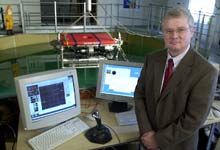Process Engineering
This special field revolves around processes for modifying material properties (milling, cooling), composition (filtration, distillation) and type (oxidation, hydration).
Valuable information is available on a broad range of technologies including material separation, laser processes, measuring techniques and robot engineering in addition to testing methods and coating and materials analysis processes.

From the bone of a horse, a new idea for aircraft structures
The horse, a classic model of grace and speed on land, is now an unlikely source of inspiration for more efficient flight.
So says a group of University of Florida engineers who have recreated part of a unique bone in the horse’s leg with an eye toward lighter, stronger materials for planes and spacecraft.
The third metacarpus bone in the horse’s leg supports much of the force conveyed as the animal moves. One side of the cucumber-sized bone has a pea-sized hole whe

UB Engineer Develops Novel Method for Assembly of Nanoparticles
Process may lead to manufacture of nanoscale devices
A University at Buffalo engineer has developed a novel method for assembling nanoparticles into three-dimensional structures that one day may be used to produce new nanoscale tools and machines.
The work could be an important step in fulfilling the immense potential of nanotechnology because it gives scientists and engineers improved control and flexibility in the creation of materials for the manufacture of many nanoscale

New Technology For Aluminium Laser Welding
Russian scientists of the Kovrov State Technology Academy have proposed a new technology for aluminium alloy welding based on using of two lasers. The first laser removes the oxide film by small portions from the surface of welded components, and the second laser executes the welding. Although the first phase lasts for about one millionth of a second, it is very important, since the refractory oxide film deteriorates the welding strength. The new method is also characterized by one more benefit: the

FaME38: Helping engineers studying critical materials
Airplane wings or railway rails are examples of mechanical components constantly submitted to stress. They consist of materials (metal alloys) with properties that may change under stress. To understand and improve such materials, it is essential to observe them on a microscopic scale. The ESRF and the ILL make today a step forward into looking deep inside engineering components. Thanks to the use of complementary neutron and synchrotron X-ray beams, these two centres offer a unique tool to measure s

Deep Sea Technology Is Put To The Test In Campus Tank
Tethered Robotic Sub Helps Engineers Refine Computerized Navigation, Control Systems
In a new indoor tank filled with almost 43,000 gallons of water, Johns Hopkins engineers are developing and testing computer control systems to serve as the “brains” for some of the world’s leading deep sea robotic exploration vehicles. To promote advances in underwater robotics, the Whiting School of Engineering recently constructed the circular hydrodynamics tank, 14 feet deep and 25 feet in diamet

Improvement and Optimisation of vibrating tables used in agri-foodstuffs sector
A research team of the Public University of Navarre (Basque Country), under the supervision of professors Jesus Zurita Gabasa and Jesus Mª Pintor Borobia, from the department of Mechanical, Energetic and Materials Engineering, is working in a project to improve and optimise vibrating tables that are used in the agri-foodstuffs sector. The project is being done by the request of the company Tecnologia Alimentaria Urtasun from Navarre (Basque Country) , manufacturer of this kind of machinery.